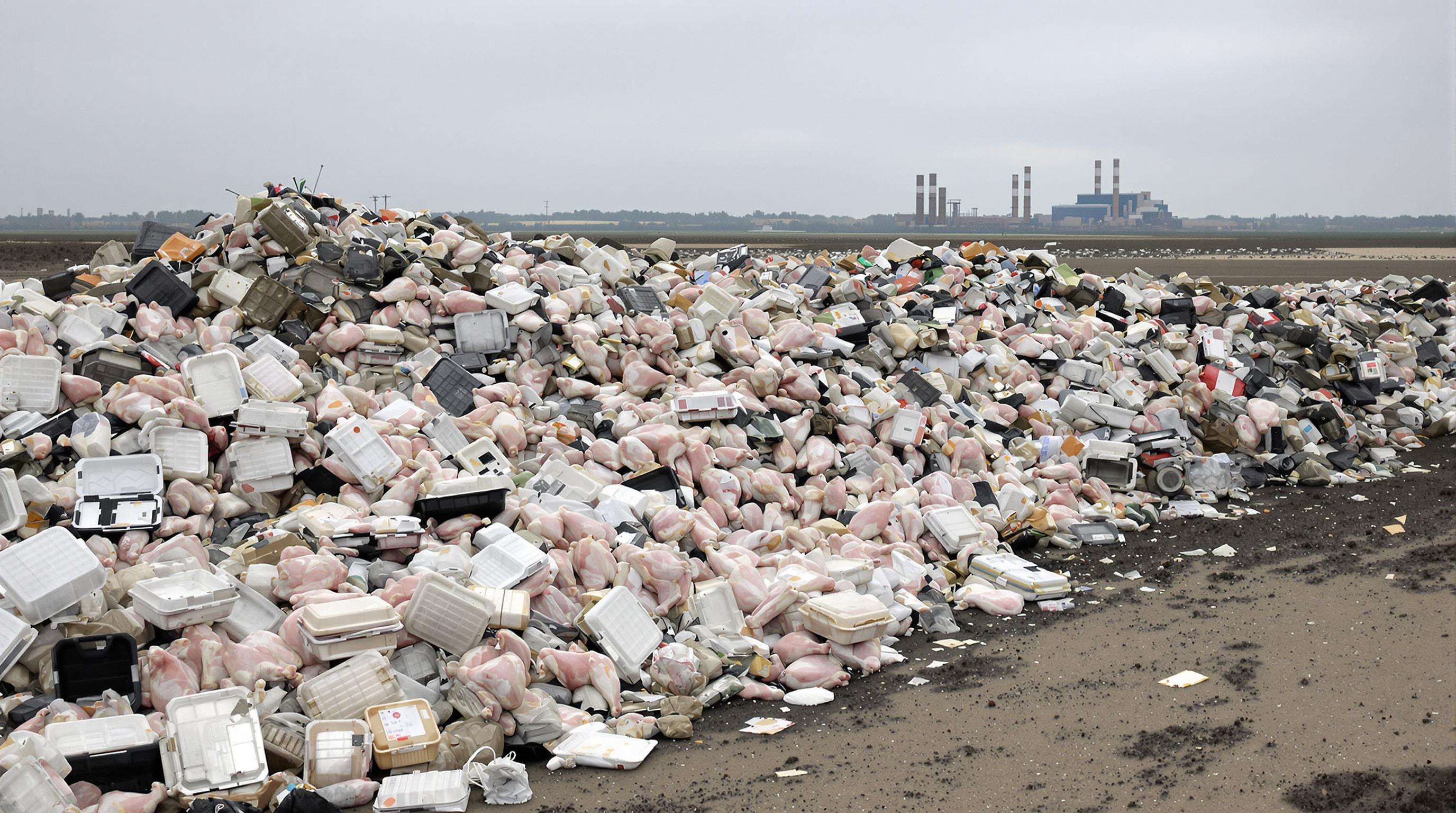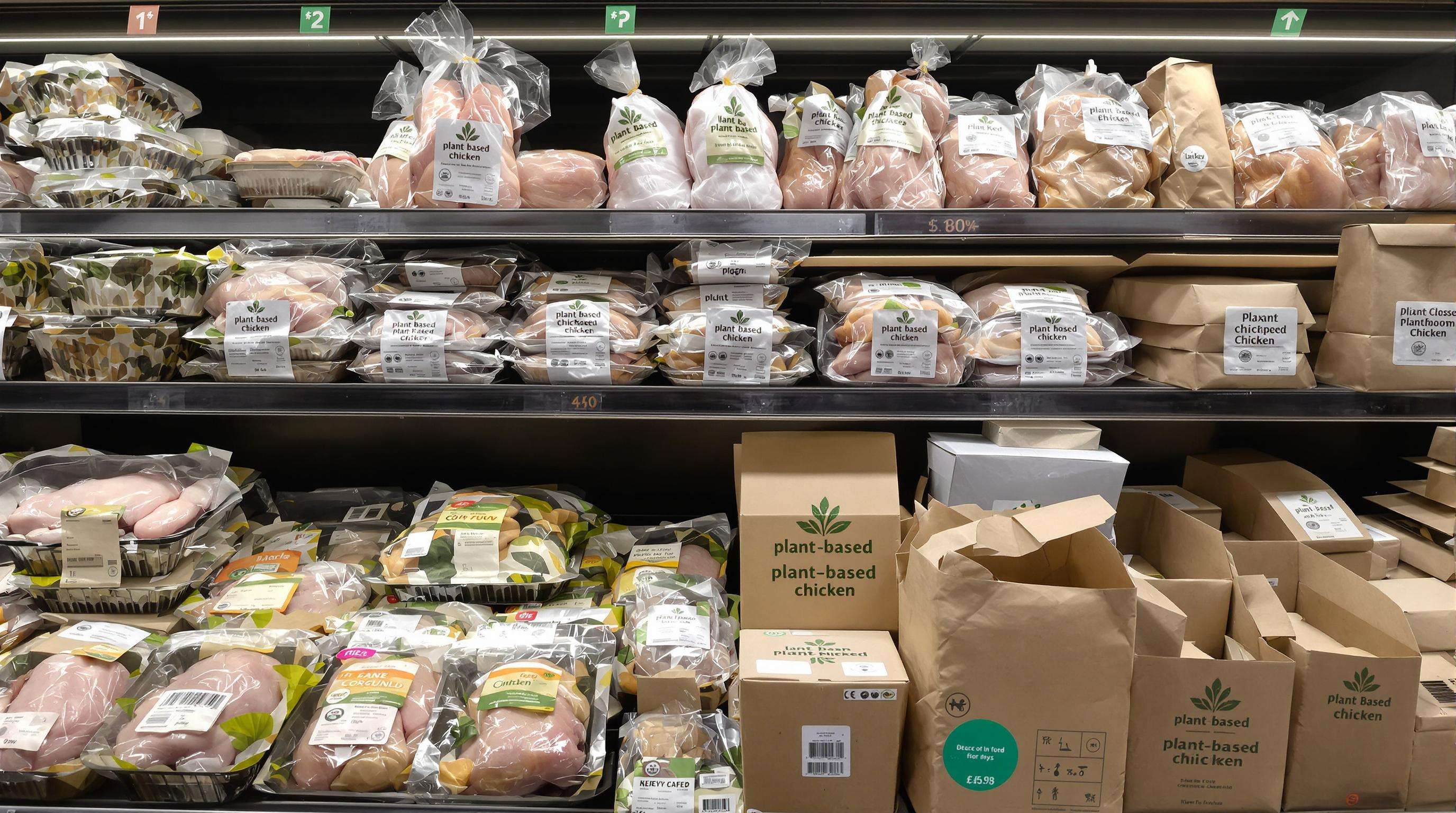เข้าใจแนวโน้มความต้องการบรรจุภัณฑ์ไก่ที่ยั่งยืนเพิ่มขึ้น บรรจุภัณฑ์ไก่
ความชอบบรรจุภัณฑ์สัตว์ปีกที่เป็นมิตรต่อสิ่งแวดล้อมของผู้บริโภคที่เพิ่มขึ้น
จากผลสำรวจล่าสุดของ DS Smith ในปี 2025 พบว่าผู้บริโภคชาวอเมริกันประมาณ 83 เปอร์เซ็นต์ให้ความสำคัญกับความยั่งยืนเป็นอันดับแรกๆ เมื่อพิจารณาบรรจุภัณฑ์อาหารในปัจจุบัน บรรจุภัณฑ์สำหรับเนื้อไก่ได้กลายเป็นเรื่องที่สำคัญเป็นพิเศษ เนื่องจากใช้พลาสติกเป็นจำนวนมาก แนวโน้มนี้มีความชัดเจนเมื่อพิจารณาจากความกังวลทางสิ่งแวดล้อมที่เพิ่มมากขึ้นที่ผู้คนจำนวนมากกำลังเผชิญอยู่ในขณะนี้ โดยประมาณ 91% ของผู้ซื้อจะพยายามหลีกเลี่ยงผลิตภัณฑ์ที่ห่อหุ้มด้วยวัสดุที่ไม่สามารถรีไซเคิลได้ โดยเฉพาะเมื่อซื้อสินค้าอย่างเนื้อไก่หรือเนื้อสัตว์อื่นๆ ที่ต้องการการเก็บรักษาในตู้เย็น
ความเต็มใจที่จะจ่ายเงินเพิ่มเพื่อแลกกับบรรจุภัณฑ์ที่ยั่งยืน บรรจุภัณฑ์ไก่
ข้อมูลล่าสุดแสดงให้เห็นว่าผู้บริโภคถึง 68% ยินดีจ่ายเงินเพิ่ม 5-7% สำหรับผลิตภัณฑ์เนื้อไก่ที่ใช้บรรจุภัณฑ์ที่ผ่านการรับรองว่าสามารถย่อยสลายได้หรือทำจากพืช มิลเลนเนียลเป็นกลุ่มที่นำเทรนด์นี้ โดยมี 74% ระบุว่าพวกเขาเคยจ่ายเงินเพิ่มสำหรับบรรจุภัณฑ์เนื้อสัตว์ที่ยั่งยืนในช่วงปีที่ผ่านมา เมื่อเทียบกับกลุ่มเบบี้บูมเมอร์ที่มีเพียง 52%
การเปลี่ยนแปลงพฤติกรรมการซื้อที่ยั่งยืนตามวัย
ผู้ซื้อเจนแซดมีแนวโน้มที่จะเปลี่ยนแบรนด์ไก่เนื่องจากปัญหาความยั่งยืนของบรรจุภัณฑ์มากกว่าคนรุ่นเก่าถึงสองเท่า กลุ่มคนรุ่นนี้มีความละเอียดอ่อนเป็นพิเศษต่อฉลากแสดงผลกระทบด้านสภาพภูมิอากาศ โดยมีผู้ซื้อถึง 82% ที่มีแนวโน้มจะซื้อผลิตภัณฑ์สัตว์ปีกที่มีการรับรองมาตรฐานสิ่งแวดล้อมจากฝ่ายที่สาม
ผลกระทบของบรรจุภัณฑ์ที่เป็นมิตรต่อสิ่งแวดล้อมต่อความภักดีในแบรนด์และการเปลี่ยนใจของผู้บริโภค
แบรนด์ที่นำบรรจุภัณฑ์ไก่ที่นำกลับมาใช้ใหม่ได้มาใช้มีอัตราการรักษาลูกค้าสูงกว่า 74% เมื่อเทียบกับแบรนด์ที่ใช้บรรจุภัณฑ์แบบเดิม อย่างไรก็ตาม 63% ของผู้บริโภคยินดีที่จะเลิกซื้อแบรนด์ไก่ที่ชอบทั้งหมดหากมีคู่แข่งเสนอทางเลือกที่ยั่งยืนกว่า ความเสี่ยงนี้ยิ่งเพิ่มขึ้นจากข้อมูลเปรียบเทียบเรื่องความยั่งยืนที่เผยแพร่ผ่านสื่อสังคมออนไลน์ในหมู่คนรุ่นใหม่
ผลกระทบต่อสิ่งแวดล้อมของแบบดั้งเดิม บรรจุภัณฑ์ไก่ และจำเป็นต้องมีการเปลี่ยนแปลง

ขยะพลาสติกและมลพิษที่เกิดจากบรรจุภัณฑ์ไก่แบบดั้งเดิม
บรรจุภัณฑ์ไก่ส่วนใหญ่ยังคงต้องพึ่งพาพลาสติกใช้ครั้งเดียวทิ้งที่เราเห็นกันอยู่ทั่วไปในปัจจุบัน เช่น ถาดโฟมและพลาสติกห่อเหนียวๆ อย่างพีวีซี ตามข้อมูลจากองค์กร Sustainable Packaging Alliance เมื่อปีที่แล้ว ระบุว่าสิ่งเหล่านี้คิดเป็นสัดส่วนประมาณ 23% ของขยะพลาสติกทั้งหมดที่เกิดขึ้นจากอุตสาหกรรมอาหาร เกิดอะไรขึ้นกับวัสดุเหล่านี้บ้าง? โดยส่วนใหญ่แล้วพวกมันก็ถูกกองทิ้งไว้ในหลุมฝังกลบจนสลายตัวกลายเป็นไมโครพลาสติกเล็กๆ ที่จะไหลลงดินและระบบแหล่งน้ำของเรา รายงานอุตสาหกรรมที่เผยแพร่ในปี 2023 ยังได้ข้อมูลน่าสนใจเช่นกันว่า ผู้บริโภคประมาณสามในสี่เริ่มมองว่าไก่ที่ห่อด้วยพลาสติกแบบนี้ส่งผลกระทบต่อสิ่งแวดล้อม คนเราจึงตระหนักมากขึ้นเรื่อยๆ ว่าทางเลือกของบรรจุภัณฑ์ที่เราใช้นั้นมีผลต่อโลกอย่างไร
บทบาทของบรรจุภัณฑ์ที่ใช้วัสดุน้อยที่สุดและรีไซเคิลได้ในการลดผลกระทบต่อสิ่งแวดล้อม
การหันมาใช้การออกแบบที่เรียบง่ายขึ้น และวัสดุอย่าง rPET ซึ่งย่อมาจาก recycled polyethylene terephthalate ช่วยลดขยะบรรจุภัณฑ์ลงได้ประมาณ 40% โดยไม่กระทบต่อความปลอดภัยของอาหาร การทำให้บรรจุภัณฑ์มีน้ำหนักเบาลงด้วยการลดการใช้วัสดุลง 15 ถึง 20% ต่อชิ้น ยังส่งผลให้การขนส่งปล่อยก๊าซเรือนกระจกน้อยลงและลดการใช้พลาสติกโดยรวม อีกทั้งการเพิ่มสัญลักษณ์การรีไซเคลอย่างเหมาะสมที่ให้ข้อมูลที่ชัดเจนแก่ผู้บริโภค ก็ช่วยให้เกิดระบบหมุนเวียนที่วัสดุถูกนำกลับมาใช้ใหม่ซ้ำๆ แทนที่จะถูกทิ้งในที่ที่ไม่เหมาะสม บริษัทต่างๆ เริ่มตระหนักว่าแนวทางนี้ไม่เพียงแต่ดีต่อโลก แต่ยังมีความคุ้มค่าทางธุรกิจเมื่อพิจารณาถึงต้นทุนในระยะยาว
Innovative Sustainable Materials Reshaping บรรจุภัณฑ์ไก่

Transition from Plastic to Plant-Based Packaging in the Poultry Industry
ผู้ผลิตสัตว์ปีกทั่วโลกต่างหันมาใช้วัสดุที่ทำจากพืชมากขึ้น เนื่องจากต้องการลดการพึ่งพาพลาสติกที่ผลิตจากเชื้อเพลิงฟอสซิล สิ่งของอย่างเช่น PLA ที่ได้จากแป้งข้าวโพด และวัสดุคอมโพสิตแปลกๆ ที่ทำมาจากเชื้อรา ใช้งานได้ค่อนข้างดีสำหรับการห่อผลิตภัณฑ์ไก่สด และสามารถลดการใช้พลาสติกได้ระหว่าง 40 ถึง 60 เปอร์เซ็นต์ ตามรายงานตลาดล่าสุด ยกตัวอย่างเช่นบรรจุภัณฑ์จากเส้นใยเห็ด ซึ่งจะสลายตัวได้หมดภายใน 45 วัน เทียบกับถาดพอลิสไตรีนทั่วไปที่ยังคงอยู่นานเป็นศตวรรษ อย่างไรก็ตาม ในขณะนี้ยังมีปัญหาใหญ่ในการขยายการใช้งานบรรจุภัณฑ์เหล่านี้ ปัจจุบันมีเพียงประมาณร้อยละสิบสองของทั้งหมดการดำเนินงานด้านสัตว์ปีกทั่วโลกเท่านั้นที่เปลี่ยนมาใช้ทางเลือกสีเขียวแบบนี้อย่างสมบูรณ์ เนื่องจากทางเลือกที่เป็นมิตรกับสิ่งแวดล้อมเหล่านี้มีค่าใช้จ่ายที่สูงกว่า และต้องใช้อุปกรณ์ที่แตกต่างออกไป ซึ่งฟาร์มส่วนใหญ่ยังไม่มีทรัพยากรหรือความสามารถในการเข้าถึง
บรรจุภัณฑ์ที่นำไปทำปุ๋ยหมักได้และย่อยสลายได้ตามธรรมชาติ: ประโยชน์และความท้าทาย
ภาพยนตร์ที่สามารถย่อยสลายได้ในเครื่องทำปุ๋ยอุตสาหกรรม โดยทั่วไปทำมาจากสิ่งต่างๆ เช่น แป้งมันฝรั่งหรือสาหร่ายทะเล ได้เสนอทางแก้ปัญหาที่สำคัญสำหรับปัญหาขยะบรรจุภัณฑ์ไก่ชนที่เพิ่มขึ้นในหลุมฝังกลบแต่ละปี เราพูดถึงขยะมากกว่า 3 ล้านตันต่อปีที่สะสมอยู่ตรงนั้น แต่มีข้อควรระวังคือ คนส่วนใหญ่ไม่ทราบวิธีจัดการบรรจุภัณฑ์ที่ย่อยสลายได้เหล่านี้อย่างถูกต้อง ผู้คนน้อยกว่าหนึ่งในสามที่ทิ้งบรรจุภัณฑ์ลงในถังปุ๋ยหมักตามที่ควรจะเป็น แต่กลับนำไปทิ้งในถังรีไซเคิลแทน แน่นอนว่าถาดที่ย่อยสลายได้เหล่านี้มีราคาสูงกว่าประมาณ 28% เมื่อเทียบกับตัวเลือกพีวีซีทั่วไป แต่ผู้ค้าปลีกสังเกตพบสิ่งที่น่าสนใจเกิดขึ้นบนชั้นวางสินค้า มีลูกค้ารู้สึกว่าถูกดึงดูดด้วยบรรจุภัณฑ์ที่ระบุว่าสามารถทำให้เป็นปุ๋ยหมักที่บ้านได้ โดยมีผู้ซื้อเกือบสองในสาม actively looking for ฉลากประเภทนี้ขณะตัดสินใจซื้อ แสดงให้เห็นว่ามีความต้องการจากผู้บริโภคที่เพิ่มขึ้นอย่างชัดเจน แม้จะมีค่าใช้จ่ายเพิ่มเติม
บรรจุภัณฑ์จากกระดาษเป็นทางเลือกที่ยั่งยืนและขยายการผลิตได้
ถาดกระดาษลูกฟูกที่มีสารเคลือบพิเศษกำลังได้รับความนิยมมากขึ้นในปัจจุบัน ตัวเลขก็สามารถบ่งชี้เรื่องราวได้เช่นกัน: ประมาณ 84% ของถาดเหล่านี้ถูกรีไซเคิล เทียบกับเพียง 9% สำหรับบรรจุภัณฑ์พลาสติกหลายชั้นที่กำจัดได้ยาก สิ่งที่น่าสนใจคือ สารเคลือบที่ปราศจากขี้ผึ้งรุ่นใหม่สามารถช่วยรักษาความสดของไก่ไว้ได้นานขึ้น 3 ถึง 5 วัน โดยไม่กระทบต่อประสิทธิภาพในการใช้งานในตู้เย็น นอกจากนี้ ร้านค้าปลีกชื่อดังอย่าง Kroger และ Costco ยังสังเกตพบว่าผลิตภัณฑ์ไก่ที่ห่อด้วยกระดาษมีแนวโน้มขายได้เร็วขึ้นกว่าเดิม ร้านค้าเหล่านี้เชื่อว่าสาเหตุหนึ่งมาจากการที่ผู้บริโภครุ่นใหม่ให้ความสำคัญกับผลกระทบต่อสิ่งแวดล้อมมากขึ้นเวลาเลือกซื้อของ
สมรรถนะและการขยายตัวของบรรจุภัณฑ์ที่ย่อยสลายได้
บรรจุภัณฑ์จากพืชอาจได้เปรียบเมื่อพูดถึงความเป็นมิตรต่อสิ่งแวดล้อม แต่ยังคงมีปัญหาในการป้องกันความชื้นเมื่อเทียบกับพลาสติกทั่วไปที่เราเห็นกันอยู่ทั่วไป ผลการทดลองในห้องแล็บปี 2024 แสดงให้เห็นว่าวัสดุที่เป็นมิตรกับสิ่งแวดล้อมชนิดนี้สามารถต้านทานความชื้นได้เพียง 15 ถึง 20 เปอร์เซ็นต์เมื่อเทียบกับทางเลือกแบบดั้งเดิม ผู้เชี่ยวชาญในอุตสาหกรรมกำลังเริ่มนำวัสดุเหลือใช้จากฟาร์ม เช่น เปลือกข้าวมาผสมเข้ากับสารประกอบชีวภาพเพื่อเพิ่มความแข็งแรงโดยไม่ต้องใช้สารเคมีสังเคราะห์ โครงการทดลองที่กำลังดำเนินอยู่ในหลายประเทศทั่วยุโรปบ่งชี้ว่าบรรจุภัณฑ์สุญญากาศที่สามารถย่อยสลายได้นี้อาจพร้อมสำหรับการผลิตในระดับอุตสาหกรรมภายในไม่ช้า โดยสามารถผลิตได้ประมาณห้าล้านถุงต่อเดือน ซึ่งเพียงพอที่จะรองรับความต้องการบรรจุภัณฑ์ไก่ในภูมิภาคนี้ได้ประมาณแปดเปอร์เซ็นต์ ถือเป็นความสำเร็จที่น่าประทับใจสำหรับบรรจุภัณฑ์ที่สามารถย่อยสลายได้ตามธรรมชาติหลังการใช้งาน
Greenwashing กับ ความยั่งยืนที่แท้จริง: การประเมินข้ออ้างเกี่ยวกับการย่อยสลายได้ตามธรรมชาติ
จากการตรวจสอบในปี 2025 พบว่าบรรจุภัณฑ์ไก่ที่อ้างว่าสามารถย่อยสลายได้ทางชีวภาพ (biodegradable) มีเพียง 22% เท่านั้นที่เป็นไปตามมาตรฐานการรับรองของ ASTM/ISO การย่อยสลายได้จริงจำเป็นต้องมีการรับรองจากบุคคลที่สาม เช่น การรับรองจาก BPI หรือ TÜV ซึ่ง 78% ของแบรนด์ไม่ได้ระบุรายละเอียดนี้ไว้บนฉลาก ผู้ตรวจสอบแนะนำให้ตรวจสอบความเข้ากันได้กับสถานที่กำจัดขยะแบบอุตสาหกรรมเพื่อหลีกเลี่ยงการโฆษณาเชิงนิเวศที่ไม่ได้ตั้งใจ
ระบบบรรจุภัณฑ์ที่นำกลับมาใช้ใหม่และรีไซเคิลได้ในภาคอุตสาหกรรมไก่
นวัตกรรมบรรจุภัณฑ์ที่สามารถนำกลับมาใช้ใหม่และรีไซเคิลได้สำหรับผลิตภัณฑ์ไก่
บริษัทชั้นนำในภาคการผลิตต่างให้ความสำคัญกับระบบวงจรปิดมากขึ้นเรื่อย ๆ ในตอนนี้ ซึ่งพวกเขาสามารถนำวัสดุเช่น ถาด PET ที่ผ่านการรีไซเคิลแล้วกลับมาใช้ซ้ำได้จริง ประมาณ 30 ครั้งก่อนที่จะส่งไปรีไซเคิลแบบสมบูรณ์ตามกระบวนการที่เหมาะสม ตามการวิจัยที่เผยแพร่เมื่อปีที่แล้วในวารสาร Sustainable Food Systems ระบุว่า แนวทางนี้ช่วยลดขยะพลาสติกได้เกือบสามในสี่เท่าของปริมาณเมื่อเทียบกับบรรจุภัณฑ์ที่ใช้ครั้งเดียวแบบทั่วไป และที่น่าสนใจไปกว่านั้นคือ มาตรฐานความปลอดภัยของอาหารไม่ได้รับผลกระทบเลยในกระบวนการนี้ สิ่งที่เราเห็นเกิดขึ้นในตอนนี้คือเทคโนโลยีที่น่าทึ่งเข้ามามีบทบาทด้วย ผู้ผลิตกำลังออกแบบโมดูลที่ช่วยให้การทำความสะอาดระหว่างการใช้งานง่ายขึ้น นอกจากนี้ยังมีภาชนะที่ติดแท็ก RFID ซึ่งสามารถติดตามจำนวนครั้งที่ภาชนะแต่ละใบถูกนำกลับมาใช้ซ้ำตลอดอายุการใช้งานของมัน การติดตามแบบนี้ทำให้ทุกฝ่ายที่เกี่ยวข้องในห่วงโซ่อุปทานเข้าใจได้อย่างชัดเจนว่าเกิดอะไรขึ้นกับวัสดุของพวกเขาตั้งแต่ต้นจนจบ
ความชอบของผู้บริโภคต่อการใช้วัสดุที่ใช้ซ้ำและรีไซเคิลได้ บรรจุภัณฑ์ไก่
ตามรายงาน Packaging Insights 2023 ระบุว่า ปัจจุบันผู้ซื้อประมาณสามในสี่คนกำลังมองหาบรรจุภัณฑ์ไก่ที่สามารถนำกลับไปรีไซเคิลได้ โดยเกือบ 60% ยินดีจ่ายเงินเพิ่มประมาณ 8 ถึง 12 เปอร์เซ็นต์ หากบรรจุภัณฑ์ดังกล่าวมาจากระบบซึ่งได้รับการรับรองว่าเป็นระบบเศรษฐกิจหมุนเวียน (Circular) อย่างถูกต้อง ความสนใจจากผู้บริโภคที่เพิ่มขึ้นนี้ กำลังผลักดันให้บริษัทผู้ผลิตไก่ต้องร่วมมือกับศูนย์รีไซเคิลในท้องถิ่น เพื่อไม่ให้ฟิล์มพลาสติกถูกทิ้งไว้ในหลุมฝังกลบเพียงอย่างเดียว เมื่อพูดถึงผลกระทบต่อโลกจริง ทางเลือกบรรจุภัณฑ์ที่สามารถใช้ซ้ำได้ ช่วยลดการปล่อยก๊าซคาร์บอนไดออกไซด์ลงได้ประมาณ 40% เมื่อเทียบกับทางเลือกบรรจุภัณฑ์ที่ย่อยสลายได้ทางชีวภาพ ในทุกภูมิภาคที่นำมาใช้ จึงไม่แปลกใจเลยว่าทำไมธุรกิจต่างๆ จึงเริ่มให้ความสนใจกับการเปลี่ยนแปลงพฤติกรรมการซื้อของเช่นนี้
แนวโน้มอุตสาหกรรมและการมุ่งมั่นของแบรนด์ต่อบรรจุภัณฑ์ไก่ที่ยั่งยืน
แนวโน้มบรรจุภัณฑ์ที่ยั่งยืนที่กำลังเปลี่ยนแปลงอุตสาหกรรมผู้ผลิตไก่
ผู้ผลิตไก่ทั่วประเทศกำลังหันไปใช้บรรจุภัณฑ์จากวัสดุเดี่ยวและสารเคลือบที่ทำจากพืชแทนการใช้พลาสติกแบบดั้งเดิม ตามข้อมูลจากการวิจัยตลาดล่าสุดที่แสดงให้เห็นว่าผู้บริโภคประมาณสองในสามของประเทศให้ความสำคัญกับบรรจุภัณฑ์ที่เป็นมิตรกับสิ่งแวดล้อม บริษัทต่างๆ จึงเริ่มทดลองใช้วัสดุใหม่ๆ หลากหลายชนิด เราได้เห็นสิ่งต่างๆ เช่น ถาดเส้นใยที่สามารถทนต่อการเปลี่ยนแปลงอุณหภูมิระหว่างการขนส่ง หรือชั้นกันความชื้นที่สกัดจากสาหร่ายที่เริ่มวางขายในซูเปอร์มาร์เก็ต นอกจากนี้ แบรนด์ใหญ่ๆ ไม่ได้แค่พูดถึงความยั่งยืนอีกต่อไป แต่พวกเขายังลงทุนพัฒนาทางเลือกที่ดีกว่าจริงๆ บางแบรนด์ใช้ลายน้ำพิเศษที่ช่วยในการคัดแยกของรีไซเคิลให้ถูกต้องที่ศูนย์ประมวลผล ในขณะที่บางแบรนด์ร่วมมือกับบริษัทเทคโนโลยีชีวภาพขนาดเล็กเพื่อพัฒนาแผ่นกระดาษลูกฟูกที่ทนต่อคราบมันโดยไม่ต้องใช้สารเคมี
เป้าหมายด้านความยั่งยืนของแบรนด์และความคาดหวังของผู้บริโภคภายในปี 2025
บริษัทผู้ผลิตสัตว์ปีกแบรนด์ดังมีถึง 40 เปอร์เซ็นต์ที่วางแผนจะเปลี่ยนไปใช้บรรจุภัณฑ์ที่สามารถนำกลับมาใช้ใหม่หรือย่อยสลายได้โดยสมบูรณ์ภายในปี 2025 โดยพวกเขาทำเช่นนี้เป็นส่วนใหญ่เนื่องจาก FTC ได้อัปเดตแนวทาง Green Guides เมื่อปีที่แล้ว ซึ่งทำให้แบรนด์ต่าง ๆ หาทางออกจากการอ้างอิงด้านสิ่งแวดล้อมที่ไม่ถูกต้องได้ยากขึ้น ผู้ซื้อในปัจจุบันต้องการหลักฐานที่ชัดเจนว่าบรรจุภัณฑ์นั้นยั่งยืนจริง ๆ สิ่งต่าง ๆ เช่น สติกเกอร์ How2Recycle และตัวเลขที่แสดงให้เห็นถึงปริมาณคาร์บอนฟุตพรินต์ได้กลายเป็นมาตรฐานที่ผู้บริโภคคาดหวังอย่างแท้จริง ตามรายงาน Food Tech Insights ปี 2025 พบว่าผู้บริโภคประมาณสามในสี่คนตรวจสอบบรรจุภัณฑ์ตามเกณฑ์เหล่านี้ก่อนตัดสินใจซื้อผลิตภัณฑ์ไก่ที่มีมูลค่ามากกว่า 32,000 ล้านดอลลาร์ต่อปี บริษัทที่สามารถควบคุมต้นทุนให้ใกล้เคียงเดิมไว้ได้ในขณะที่เสนอทางเลือกที่เป็นมิตรต่อสิ่งแวดล้อมนั้น มีความภักดีจากลูกค้าเพิ่มขึ้นประมาณร้อยละ 22 เมื่อเทียบกับบริษัทที่ยังคงใช้บรรจุภัณฑ์พลาสติกแบบดั้งเดิม สิ่งนี้มีความสมเหตุสมผลเมื่อพิจารณาว่าผู้บริโภคในปัจจุบันมีจำนวนมากเพียงใดที่มองหาทางเลือกที่เป็นมิตรต่อสิ่งแวดล้อม
กรณีศึกษา: แบรนด์ไก่รายใหญ่หันมาใช้บรรจุภัณฑ์ที่ย่อยสลายได้ตามธรรมชาติภายในปี 2024
หนึ่งในผู้ผลิตไก่รายใหญ่ที่สุดของอเมริกาได้เปลี่ยนแปลงครั้งใหญ่ในปี 2024 โดยเปลี่ยนบรรจุภัณฑ์ของผลิตภัณฑ์ไก่สดประมาณ 85% เป็นถุงสุญญากาศที่ทำจากเส้นใยเห็ดแทนพลาสติกทั่วไป บริษัทได้ลงทุน 18 ล้านดอลลาร์ในโครงการนี้ ซึ่งช่วยลดขยะที่จะนำไปทิ้งในหลุมฝังกลบได้ปีละประมาณ 1,200 ตัน โดยยังคงมาตรฐานความสดของสินค้าที่ 21 วันตามที่ลูกค้าคาดหวัง ยอดขายเพิ่มขึ้นจริงๆ ถึง 31% ในหมู่ผู้ซื้อวัยรุ่นตอนปลายที่ใส่ใจเรื่องสิ่งแวดล้อม ซึ่งแสดงให้เห็นว่าบรรจุภัณฑ์ที่ย่อยสลายได้เหล่านี้สามารถใช้งานได้ดีในเชิงพาณิชย์ หากผู้บริโภคเข้าใจวิธีกำจัดหลังใช้งานอย่างเหมาะสม
คำถามที่พบบ่อย
เหตุใดบรรจุภัณฑ์ไก่ที่ยั่งยืนจึงมีความสำคัญ
บรรจุภัณฑ์ไก่ที่ยั่งยืนมีความสำคัญในการลดขยะพลาสติกและมลพิษ รวมถึงตอบสนองความต้องการของผู้บริโภคที่เพิ่มขึ้นสำหรับผลิตภัณฑ์ที่เป็นมิตรกับสิ่งแวดล้อม นอกจากนี้ยังช่วยให้ผู้ผลิตเนื้อไก่สามารถสอดคล้องกับเป้าหมายด้านสิ่งแวดล้อม และเสริมสร้างความภักดีต่อแบรนด์
บรรจุภัณฑ์ที่สามารถย่อยสลายได้มีประโยชน์อย่างไร
บรรจุภัณฑ์ที่สามารถย่อยสลายได้ช่วยลดขยะในหลุมฝังกลบ ลดผลกระทบต่อสิ่งแวดล้อม และดึงดูดผู้บริโภคที่ใส่ใจสิ่งแวดล้อม อย่างไรก็ตาม บรรจุภัณฑ์ประเภทนี้ต้องการวิธีการกำจัดที่เหมาะสมเพื่อให้เกิดประสิทธิภาพ
บรรจุภัณฑ์ที่ยั่งยืนมีอิทธิพลต่อพฤติกรรมของผู้บริโภคอย่างไร
บรรจุภัณฑ์ที่เป็นมิตรกับสิ่งแวดล้อมช่วยเพิ่มอัตราการรักษาลูกค้าและสร้างความภักดีต่อแบรนด์ให้สูงขึ้น ผู้บริโภคจำนวนมากยินดีจ่ายเงินเพิ่มสำหรับผลิตภัณฑ์ที่ใช้บรรจุภัณฑ์ที่ยั่งยืน และบางคนอาจเปลี่ยนแบรนด์เพื่อเลือกผลิตภัณฑ์ที่เป็นมิตรกับสิ่งแวดล้อมเป็นสำคัญ
การนำบรรจุภัณฑ์ที่ยั่งยืนมาใช้มีอุปสรรคหรือไม่
มี อุปสรรคที่พบ ได้แก่ ต้นทุนวัสดุที่สูงขึ้น การขาดอุปกรณ์สำหรับการผลิต กระบวนการขยายการผลิตให้ใหญ่ขึ้น และการให้ความรู้แก่ผู้บริโภคเกี่ยวกับวิธีการกำจัดที่เหมาะสม เพื่อป้องกันการเกิดการโฆษณาเชิงนิเวศน์ที่เกินจริง (Greenwashing)
แนวโน้มของอุตสาหกรรมมีผลต่อการนำบรรจุภัณฑ์ที่ยั่งยืนมาใช้อย่างไร
แนวโน้มอุตสาหกรรมได้ผลักดันให้แบรนด์ไก่รายใหญ่หันมาใช้บรรจุภัณฑ์ที่รีไซเคิลและย่อยสลายได้ตามธรรมชาติ ซึ่งได้รับแรงผลักดันจากข้อบังคับที่ปรับปรุงใหม่ ความต้องการของผู้บริโภค และต้นทุนที่อาจประหยัดได้ในระยะยาวของการดำเนินงาน
สารบัญ
- เข้าใจแนวโน้มความต้องการบรรจุภัณฑ์ไก่ที่ยั่งยืนเพิ่มขึ้น บรรจุภัณฑ์ไก่
- ผลกระทบต่อสิ่งแวดล้อมของแบบดั้งเดิม บรรจุภัณฑ์ไก่ และจำเป็นต้องมีการเปลี่ยนแปลง
-
Innovative Sustainable Materials Reshaping บรรจุภัณฑ์ไก่
- Transition from Plastic to Plant-Based Packaging in the Poultry Industry
- บรรจุภัณฑ์ที่นำไปทำปุ๋ยหมักได้และย่อยสลายได้ตามธรรมชาติ: ประโยชน์และความท้าทาย
- บรรจุภัณฑ์จากกระดาษเป็นทางเลือกที่ยั่งยืนและขยายการผลิตได้
- สมรรถนะและการขยายตัวของบรรจุภัณฑ์ที่ย่อยสลายได้
- Greenwashing กับ ความยั่งยืนที่แท้จริง: การประเมินข้ออ้างเกี่ยวกับการย่อยสลายได้ตามธรรมชาติ
- ระบบบรรจุภัณฑ์ที่นำกลับมาใช้ใหม่และรีไซเคิลได้ในภาคอุตสาหกรรมไก่
- แนวโน้มอุตสาหกรรมและการมุ่งมั่นของแบรนด์ต่อบรรจุภัณฑ์ไก่ที่ยั่งยืน
- คำถามที่พบบ่อย

